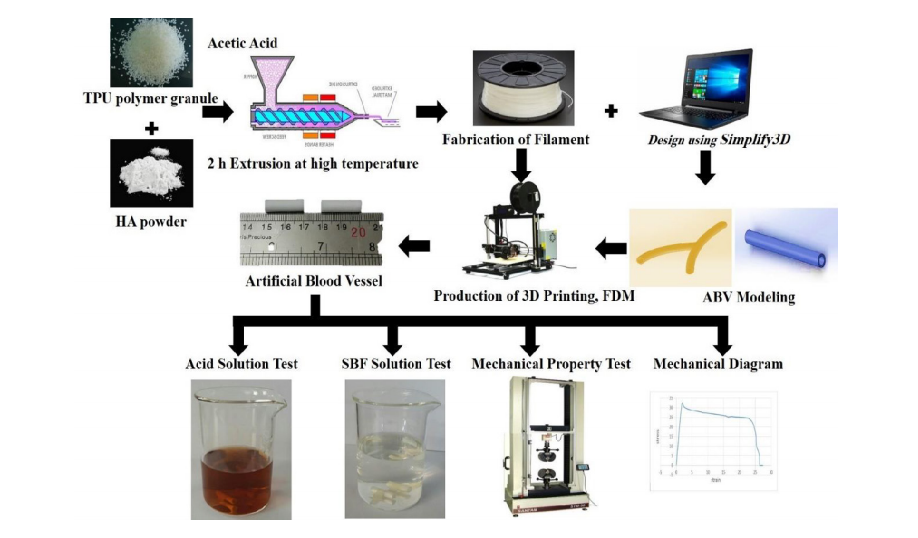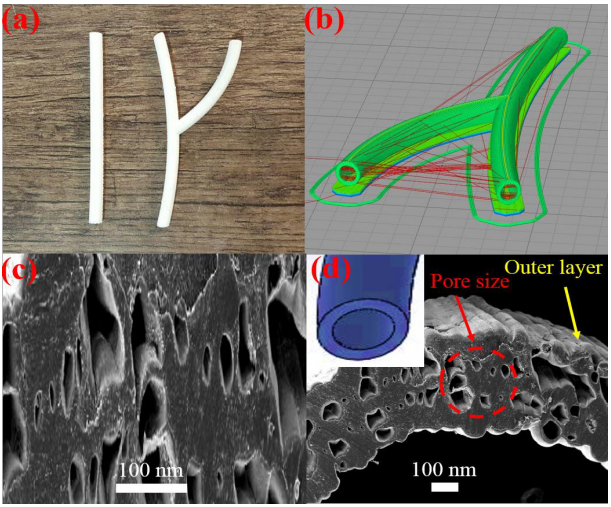In their recently published paper, ‘An artificial blood vessel fabricated by 3D printing for pharmaceutical application,’ researchers discuss not only the dangers of cardiovascular diseases as the number one cause of mortality for seniors, but also new methods via 3D printing for creating Artificial Blood Vessels that could improve the quality of life for patients, along with reducing cardiac arrest and infections, in the future.
Historically, Artificial Blood Vessels (ABV’s) have presented so many challenges that researchers have looked for other methods for vascular support. In this study, the researchers attempt to 3D print a new, artificial bio-composite blood vessel with polymer materials and bioceramic nanoparticles; specifically, the used thermoplastic polyurethane (TPU) composed of nanocrystalline hydroxyapatite (HA) nanopowder.

Schematic design and construction of dual-component bio-nanocomposite ABV using 3D printer machine, HA powder, and TPU polymer
By no means is such experimentation new to scientists, with documentation dating back to 1912 stating that researchers began using a combination of metal and glass tubes to make artificial arteries for dogs in need of heart surgery. Other later, more progressive studies show that researchers were able to create polymer substrates for arterial replacement. Medication has been the predominant method for treating patients with cardiovascular disease (CVD) though, along with surgery.
As the researchers began their journey to fabricate artificial veins, much consideration was given to the proper biocompatible material. The filament was created in three separate steps:
- Nanocrystalline HA powder was created with bovine bone, milled for ten hours and then heated to 800-850°C for three hours to purify the material.
- TPU polymer was ground into smaller particles and then was combined with an HA powder concentration.
- The filament was 3D printed to make artificial veins, each with a diameter of six millimeters.

ABV designed in CAD software; a) Multiple branches, b) Two branches, and c) Single branch using solid work software
The researchers pointed out that while drawbacks of TPU are wear resistance and some ‘lack of clarity’ in different solvents, there were advantages, including:
- High strength
- Biocompatibility
- Non-adhesion
- High polarity
“The TPU biopolymer was mixed with various concentrations of the HA power (0, 2.5, 5, and 7.5 wt%) in a high-energy ball milling machine,” explained the researchers. “Following that, the mixed composite powders were inserted into the extrusion machine at a specific heating rate. Afterwards, the obtained results with the homogenized TPU-HA filament were extracted and inserted into the 3D printing machine.”

a) Designed two-branch ABV, b) Approaches to designing vessels in solid works software and ABV model in Simplify 3D software, c) Top of SEM image and d) Lateral view of SEM image constructed by 3D printer (pore size: 50-100 microns)
Upon evaluating mechanical and biological properties, the researchers discovered that biodegradability of the polymer was transformed and affected mechanical properties. ABVs were found able to function in the human body ‘several times,’ and survived both high blood pressure and pulmonary vein movement.
“… the new biotech ABVs are tight, flexible, and resistant to clotting, while they also have an adaption system to heart palpitations based on nanotechnology and the loading of specific microscopic molecules inside the bonds. Utilization of atomic- and molecular-level analytical materials along with nanotechnology enables these thorns to the magnetic core (stem cells). When stem cells are absorbed, they cover the entire inner surface of the stem and become endothelial cells. Use of these polymeric materials enables transplantation in human ABVs, helping deliver nutrients to the tissues of the body,” state the researchers.
Their true goal is to use the links between coronary and lower-extremity arteries to prevent cardiac arrest, as well as amputation. The research team also suspects that ABVs could provide both biocompatibility and non-toxicity resistance in infections, along with offering polyurethane-like mechanical and blood compatibility. They also add that in using a varied, ‘triangular motion’ in FDM 3D printing, there is the potential for a more homogenized vessel in comparison to other high porosity motions—allowing for better control regarding porosity of the ABV wall.
Overall, while challenges remain in the use of artificial veins, the researchers state that they considered ‘selective vessels for vascular replacement,’ but alternatives—especially those able to accommodate patients with smaller veins—must be created.
“According to the findings, the combination of the analytical model and experimental evaluation could be utilized to simulate the micromechanical behavior of arterial blood vessels. It is also notable that the porosity of blood vessels significantly affects the shear stress and elastic modulus of the veins. In this regard, our findings indicated the significant effect of the rheological behavior of blood on shear stress variations,” concluded the researchers.
“The results of the present study demonstrated the effect of the obstruction rate, location of the pores, and degree of reinforcement in the veins on the elastic modulus and porosity of the tube. Moreover, the biological behavior of the specimens indicated that the addition of bioceramic could enhance the elastic modulus response of the tubes.”
Because cardiovascular disease is such a prevalent killer of humans, researchers around the world are continually focused on innovating to improve the lives of patients (sometimes saving them altogether), from 3D printing blood vessels for children to experimenting with vascular patches and training devices too, like heart models.
Find out more about researchers 3D printing artificial blood vessels here. What do you think of this news? Let us know your thoughts! Join the discussion of this and other 3D printing topics at 3DPrintBoard.com.

Results of biological testing of artificial bio-nanocomposite made by 3D printing soaked in a) Acid solution, b) Sample fixation in saline solution, and c) SBF solution for 21 days
Subscribe to Our Email Newsletter
Stay up-to-date on all the latest news from the 3D printing industry and receive information and offers from third party vendors.
You May Also Like
Creality Begins Selling HALOT-MAGE S: Setting New Standards in Precision 3D Printing
Creality, a leading innovator in consumer-grade 3D printing technology, proudly introduces the HALOT-MAGE S, the latest breakthrough in high-resolution 3D printing. With its cutting-edge features and user-centric design, the HALOT-MAGE...
Farsoon Showcases Comprehensive 3D Printing Solutions, Automation, and More at TCT Asia
This year’s TCT Asia event showcased just how much the Asian additive manufacturing (AM) market has grown, with Eplus3D’s 64-laser metal 3D printer alone acting as a synecdoche for China’s...
Creality Launches Ender-3 V3 Plus: Bigger CoreXZ for Unprecedented Performance
Embracing a journey of innovation and excellence, Creality’s Ender-3 series has established a distinguished path in the field of 3D printing. From the entry-level Ender-3 V3 SE to the feature-rich...
Laser Wars: Eplus3D Unveils Metal 3D Printer with up to 64 Lasers
Now that the laser wars in the powder bed fusion (PBF) space have, for the most part, moved to China, original equipment manufacturers (OEMs) there are in fierce competition. Eplus3D...
































